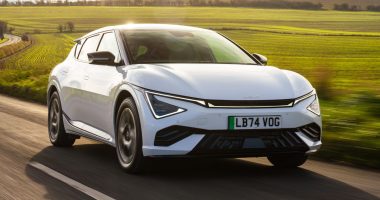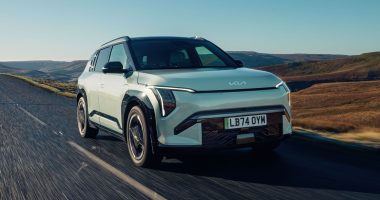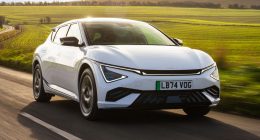Honda is confident it has finally cracked the code on its sixth attempt with the latest CR-V. Why do we think that? Well, just seven words into a rather long-winded press release that sings the praises of this Chinese-made petrol-hybrid, and plug-in hybrid-powered car, ‘ultimate all-round SUV’ appear.
This CR-V is the latest in a long-line of either reinvented or entirely new nameplates Honda has churned out over the course of the past three-or-so years. Before it came the Jazz supermini, HR-V crossover, e:Ny1 electric vehicle, and the Civic hatchback which also inspired the creation of the jacked up ZR-V.
Sitting on a wheelbase that is stretched by 40mm, the CR-V’s presence is dialled up to eleven thanks to the body being 10mm wider and 80mm longer for increased passenger space and cleverer interior packaging. Two grille designs – one for e:HEV and another for e:PHEV – is paired to slim, angular lights at the front and LED tail-lights that extend towards the roofline, much like that found on Volvo’s XC90.
Stylists have also played with the position of the A-pillar, moving these back further to allow for a longer bonnet, while side-on, the flat arches are more than a nod to what is found on Mazda’s SUVs. Options include a choice of six body colours – four being all-new, such as ‘Diamond Dust Pearl’ and ‘Canyon River Blue Metallic’ – and two seen on the previous generation. e:HEV and e:PHEV are further set apart by the use of piano black trim on the latter’s rear roof spoiler, side mirror caps and grille bar.
Delve deeper, and Honda’s stylists have managed to incorporate aids intended to increase efficiency; vertical slots either side of the grille force air along the predominantly smoothed out sides, whilst e:HEV variants incorporate a shutter grille that can open – and close – of its own volition. Clever stuff.
So, what does this equate to in terms of real-world MPG? Honda claims the self-charging hybrid is good for 42mpg – a figure that could be better were it not for the fact these models are four-wheel-drive. The added weight hurts the wallet, and it takes the sharp edge off performance as the sprint to 62mph takes 9.4 seconds. In this guise, the 146bhp 2.0-litre petrol engine serves mostly as a generator, feeding the dinky 1.06kWh battery pack that sends power to the 181bhp electric motors that turn the 18-inch wheels.
Or there is the option of a PHEV – as tested here in the highest spec ‘Advance Tech’ (£53,995) – that guarantees 51-miles of pure electric motoring and upwards of 350mpg should you routinely connect the 17.7kWh battery to a work, public or home charger.
The CR-V is a car best enjoyed driven in a relaxed and controlled manner as it is smooth and quiet for the most part, and supremely refined. True, it isn’t going to set any pulses racing from a purely dynamic perspective, yet it is worth saying the body is nicely tied down to prevent wallow as you navigate a roundabout or a series of quick-fire bends.
PHEV owners have five drive modes to pick from via the centre console but keep it in ‘Normal’ and the CR-V is a truly relaxing cruising partner, aided by the larger battery that ensures the Atkinson engine remains at rest for more of the time. Passengers lounging in the second row are sure to appreciate the calm, especially as their chairs recline through eight positions to increase comfort on longer journeys. Rear doors that open up to ninety degrees aid access to the back where bucket loads of leg and foot room come courtesy of a largely flat floor due to how the electrical gubbins are positioned.
Up front, the architecture is all very familiar due to the fact it is already in service in the Civic and that is a good thing for the simple reason the technology is intuitive and the construction reassuringly solid. Some aspects feel below par and nothing more than average – disappointing considering the inflated ticket price – and the same can be said for the legible but flat graphics on the 10.2-inch digital driver display and 9-inch multimedia system that combines touch inputs with a physical ‘Home’ and ‘Return’ shortcut button, and a knurled knob for turning the eight-speaker Bose sound system up, down or off.
A panoramic glass roof, LED lights, power-operated tailgate, reversing camera, front and rear parking sensors, keyless entry and wireless smartphone charging are standard across the line-up, with mid-spec ‘Advance’ adding a multi-view camera, heated seats and steering wheel, and a head-up display. In the case of ‘Advance Tech’, the big talking point is the introduction of the company’s omnidirectional safety and driver assist system called ‘Sensing 360’. This is the first time it has featured on a European Honda and works by monitoring the vehicle’s surroundings and removing blind spots to avoid shunts.









